 Previous Article
Previous Article
The Ultimate UK Guide to Pet-Friendly Composite Decking
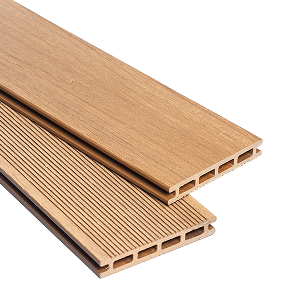
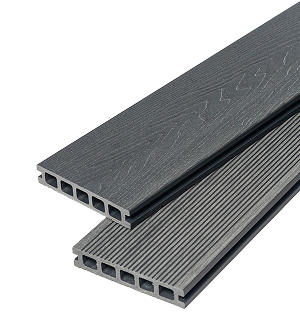
Looking to upgrade your garden? The main question for many homeowners is whether to opt for the natural feel of outdoor decking or the modern, hard-wearing surface of paving.
These two options are the most common choices in the UK, and in this definitive guide, we will compare them on the key factors that our customers tell us matter most. We’ll give you a clear understanding of which solution is right for you.
For a rapid comparison, see our “At a Glance” table below, or use the “Jump To” menu to navigate to the section that interests you most.
| Feature | Decking (Composite & Wood) | Paving (Porcelain & Stone) |
|---|---|---|
|
|
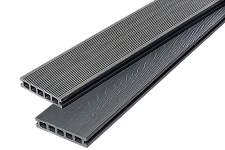
|
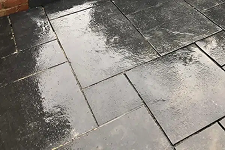
|
| Aesthetics | Natural, warm, "outdoor room" feel. | Hard, sleek, modern or traditional patio look. |
| Maintenance Level | Very Low (Composite) to Very High (Wood). | Low (Porcelain) to Medium (Stone/Concrete). |
| Upfront Cost | Varies widely from low-cost softwood to premium composite. | Varies widely from budget concrete to premium porcelain. |
| Durability | Good to Excellent. Resists cracking. | Excellent. Can be prone to cracking if installed incorrectly. |
| Best For... | Creating raised areas, sloped gardens, and a warm, comfortable surface. | Creating a durable, flat, hard-wearing patio or path. |
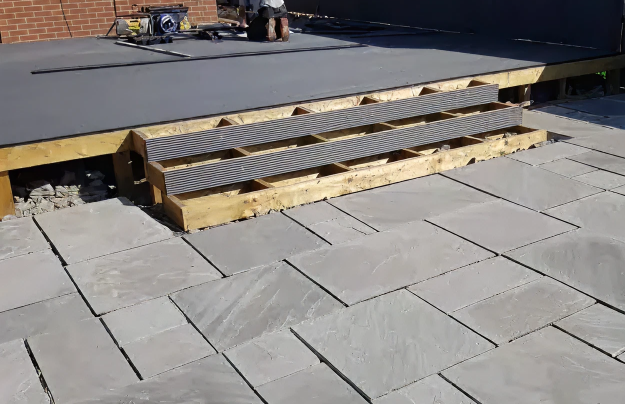
How your new space looks and feels is arguably the most important factor.
This is a modern solution available in an array of colours and patterns. It can elevate and enhance most garden designs with its sleek and bold appearance.
Offers natural colours of beige, brown, and red, creating a warm, rustic appearance.
A common and timeless solution that normally comes in a light grey appearance, giving you a blank canvas for your design.
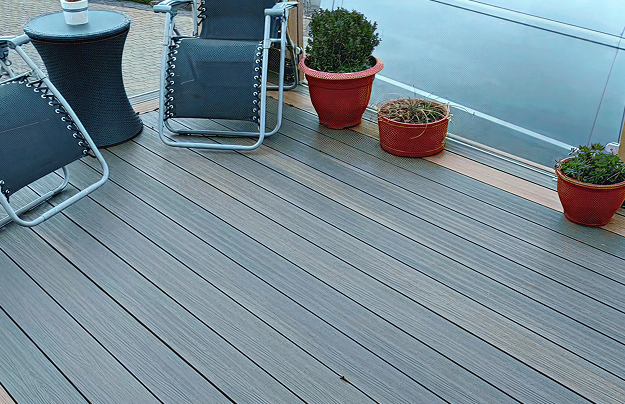
Available in softwood and hardwood, nothing quite beats the real, natural feel of timber. These boards create a warm and relaxed feel that connects your garden with nature.
This solution is designed to eliminate the drawbacks of timber. It can elevate a space with its contemporary colours and designs or capture the true natural authenticity of wood with its warm and cosy browns.

This is down to personal preference. If you’re looking for a warm, natural appearance, then Indian stone, wood, or high-quality composite decking can all achieve this. If you are looking for a sleek, modern, and contemporary design, then porcelain tiles or modern composite decking will bring your project to life.
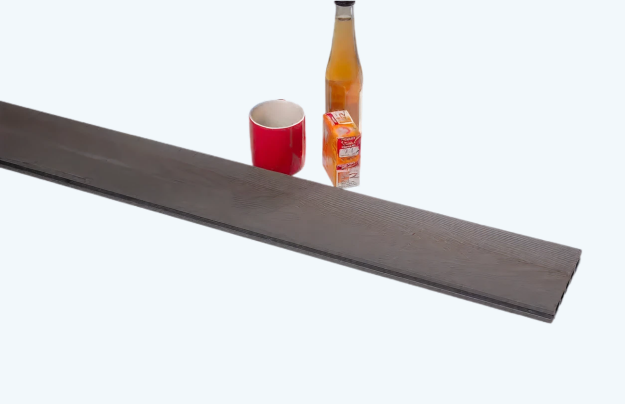
Just like porcelain, composite absorbs minimal moisture. This means it requires only seasonal maintenance for capped versions and regular cleaning for uncapped versions. Its key advantage is its stain resistance.
Of all the paving options, porcelain reigns supreme on maintenance. Due to its low porosity and resistance to moisture, it’s a very low-maintenance solution, though the joints will need to be checked over time.
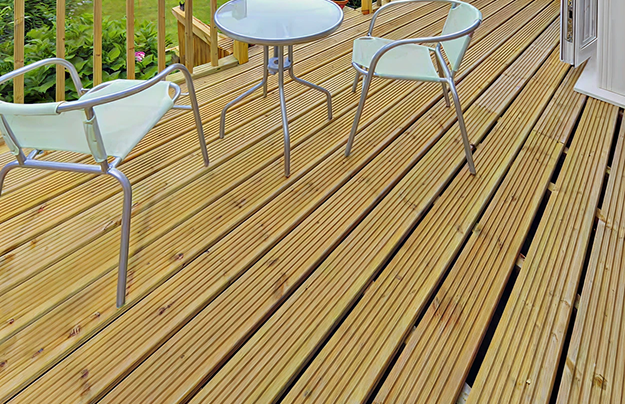
Wooden decking requires the most maintenance of all solutions. You will need to seal it annually and stain or paint it every few years to ensure its longevity. If not, wood can have a short lifespan, rotting in as little as 5 years.
These will need to be maintained regularly to retain their appearance by preventing weeds and cleaning. It is also advisable to seal them every few years for increased protection. Over time, you will eventually have to top up or replace the jointing compound.
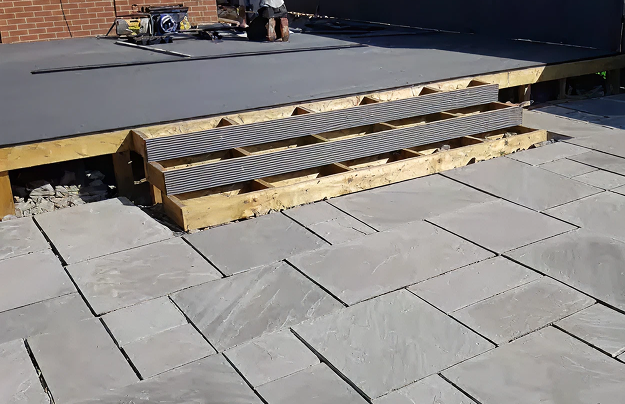
Offers great value for money. Prices can start from as little as £25 per sqm, reaching up to £65+ per sqm for premium Italian designs.
These are cost-effective solutions, with prices for both starting from £20 per sqm and rising to £40-£50 per sqm depending on quality.

A cost-effective solution for a short-term project. Per square metre, prices start from £20 to £45 for softwood, with hardwood reaching up to £80 to £120.
With its enhanced moisture and stain resistance properties, composite offers great value for money. Prices start from £33 to £70 per sqm.
Porcelain paving has a huge advantage here, as it expands and contracts minimally, which helps prolong its life and reduces the risk of cracking. All other materials—Indian stone, concrete, wood, and composite—will expand and contract with seasonal temperature changes, meaning correct installation with proper expansion gaps is essential. Wooden decking is the weakest in this category, as its high moisture absorption leads to a cycle of swelling and shrinking that increases the risk of rotting and warping.
| Material | Expansion/Contraction Risk | Key Takeaway |
|---|---|---|
| Porcelain Paving | Very Low | The most stable option; highly resistant to cracking. |
| Composite Decking | Medium | Requires correct expansion gaps during installation. |
| Indian Stone / Concrete | Medium | Requires correct expansion gaps during installation. |
| Wooden Decking | High | Most susceptible to warping, rotting, and decay from moisture. |
Porcelain paving offers great slip resistance, as outdoor versions are manufactured with a textured surface and often come with an R11 slip rating. Composite decking in all ranges also offers excellent slip resistance, achieving a low-to-medium risk rating even in very wet conditions. Both Indian stone and concrete offer good slip resistance, but only if they are properly maintained to prevent the build-up of moss and algae. Wood decking is the most likely to become slippery when wet, and may require anti-slip strips to be safe.
| Material | Slip Resistance Rating | Key Requirement |
|---|---|---|
| Porcelain Paving | Excellent | Look for an R11 slip rating for proven performance. |
| Composite Decking | Excellent | Inherently slip-resistant; grooved/textured is best. |
| Indian Stone / Concrete | Good | Requires regular cleaning to prevent slippery algae. |
| Wooden Decking | Poor | Becomes very slippery; may require anti-slip strips. |
Of the paving options, Indian stone (a natural, quarried product) and Porcelain (made from natural clay and minerals and is recyclable) are the best choices. Concrete paving is not eco-friendly as it consumes a large amount of energy to produce. For decking, composite is the clear winner. It is made from recycled plastic and wood fibres and has a lifespan of decades. Pressure-treated wood is the poorest option, as it uses chemicals and is often considered hazardous waste at the end of its life.
| Material | Eco-Friendly Rating | Key Requirement |
|---|---|---|
| Composite Decking | Excellent | Made from recycled plastic and wood fibres. |
| Porcelain Paving | Good | Made from natural materials and is recyclable. |
| Indian Stone | Good | A natural, quarried product. |
| Concrete Paving | Poor | High energy consumption during production. |
| Pressure-Treated Wood | Very Poor | Treated with chemicals; considered hazardous waste. |
While we are a composite decking supplier and may be a little biased, looking at the data openly and honestly, it comes down to two front-runners for most projects: Porcelain Paving and Composite Decking.
Why? Both materials offer exceptional long-term benefits for a reasonable upfront cost. They both have excellent resistance to moisture and require very little maintenance over the years to ensure they stay looking great and performing well.
Your final choice depends on the specific benefits you value most. Porcelain paving has extremely low expansion rates, while capped composite decking offers superior stain and fade resistance.
However, if your project is for a shorter term (under 10 years) or on a very tight budget, then Indian stone, concrete paving, and wood become the best options for that specific timeframe.
 Previous Article
Previous Article
The Ultimate UK Guide to Pet-Friendly Composite Decking

Does Composite Decking Expand? An Ultimate Guide to Installation Gaps